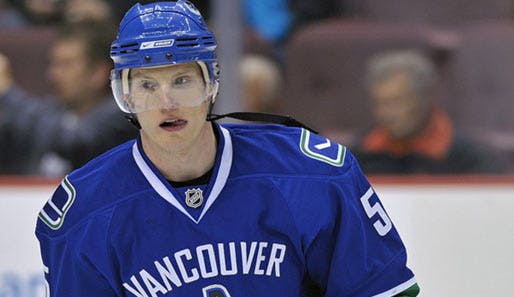Replacing Christian Ehrhoff

In the days that followed Vancouver’s heartbreaking Stanley Cup final loss GM Mike Gillis was tasked with maintaining the status-quo on the Canucks’ back-end with an emphasis on re-signing key defensemen Kevin Bieksa and Christian Ehrhoff.
Bieksa quickly re-signed for five years and $23 million, while Ehrhoff walked away from the same offer and signed with the suddenly free-spending Buffalo Sabres for 10 years and $40 million.
While it’s easy to dismiss Ehrhoff as a mere power-play specialist and poor playoff performer, an abysmal -13 in the 2011 post-season, his exodus from the Canucks’ blueline represents a significant loss.
Firstly, Ehrhoff led all Vancouver skaters in total ice-time and even-strength ice-time in 2010-11, in both cases, by considerable margins. Ehrhoff’s expansive minutes logged are a function of his health, no other Canuck defenseman suited-up for more than 66 games, but also head coach Alain Vigneault’s reliance on the 29-year-old in select situations.
Alexander Edler averaed 24:17 total ice-time per game, Ehrhoff was second on the Canucks with an average of 23:59. Ehrhoff and Edler both averaged a team-high 18:17 even strength ice-time per game.
It should be noted that the German defender played some of the easiest minutes on the squad, with a sixth-ranked quality of competition rating among Canuck blueliners.
Ehrhoff and Edler were frequently deployed as a five-man unit along with the Sedin twins and Alex Burrows line. As Jonathan Willis pointed out, Ehrhoff was used in offensive zone situations at a greater rate than any other Vancouver defender.
A full-season of Sami Salo, a pipedream, I know, would go a long way to filling the offensive-zone ice-time void left by Ehrhoff, as the smooth Finnish rearguard was third among Canuck defensemen with a zone-start ratio of 53.5.
Bieksa and Dan Hamhuis, who emerged as Vancouver’s shutdown pair, will likely be called upon to log more even-strength ice-time, both of whom averaged nearly 18 minutes per game last season. The duo also played some of the hardest minutes on Vancouver, both earning a top-three quality of competition rating among Vancouver rearguards.
The emergence of Chris Tanev and a rebound season from Keith Ballard, neither of whom averaged more than 16 minutes per game, are also imperative to the success of Vancouver’s back-end. The latter certainly has the fitness to handle the extra minutes, Ballard averaged more than 20 minutes per game prior to 2010-11, but will first have to regain the trust of Vigneault.
Say what you will about the Hoff’s toughness and compete level, the native of Moers, Germany was a minute-eater on the back-end and in his absence Vancouver will need all six of its defensemen to log much more ice-time.
Ehrhoff’s prowess on the man-advantage will certainly be missed, as the German was an integral component of the Canucks top-ranked power-play. Ehrhoff’s 28 power-play points, 6 goals and 22 assists, were fourth among NHL blueliners.
Vancouver’s first-unit on the power-play, comprised of Daniel and Henrik Sedin, Ryan Kesler, Edler and Ehrhoff, contributed 52 of the team’s 72 goals on the man-advantage.
Edler was a distant second with 17 power-play points from the back-end, but the Swede played in just 51 regular-season games. It’s reasonable to expect Edler, should he be healthy, to produce 25 to 30 points on the man-advantage. The 6-foot-3 defenseman’s spot on the first power-play unit is a certainty, though there are several candidates to man the point alongside Edler.
Salo is an obvious front-runner, as he averaged 1:54 power-play ice-time per game and possesses one of the league’s hardest shots. In 27 regular-season games, Salo tallied just three points on the man-advantage. His career-high in power-play points, 20, came in 2005-06. The notoriously injury prone 36-year-old could be used in spot-duty on the first-unit, but is far from a sure thing at this point.
Mikael Samuelsson logged considerable minutes on the power-play last season, sixth most on the team, and found himself on the point on the man-advantage for much of the season due to a myriad of injuries to the Canucks’ blueline. Samuelsson had five goals and 19 points on the power-play last season. The 34-year-old winger is an adequate playmaker from the point but lacks a powerful slap-shot which could lead to opposing defenders overplaying Edler’s booming one-timer.
The wonderfully well-rounded Hamhuis quietly amassed seven points on the power-play while playing exclusively with the second-unit. The Smithers native has terrific hockey sense but has never tallied more than 16 points on the man-advantage and seems destined for second-unit duty.
We’re still waiting for Bieksa to re-discover his 2008-09 form in which the rugged blueliner was a dynamo on the man-advantage notching five goals and 25 points. Bieksa has just one power-play goal in each of the last two seasons, despite his 113 minutes logged on the power-play in 2010-11. If Bieksa can find the net at the same rate as 2008-09, when his shooting percentage was 7.2%, he could find himself as a mainstay on the first-unit.
Ballard will have to escape Vigneault’s doghouse before he’s seriously considered for power-play ice-time, but the much-maligned American does possess puck-moving ability from the back-end. Prior to his disastrous debut season in Canuck blue, Ballard averaged nearly 30 points in his first five NHL seasons.
The Canucks had a league-best 72 goals on the man-advantage in 2010-11, but were a distant seventh in the league in five-on-five goals for. Whether it’s done individually or by committee, replacing Christian Ehrhoff’s power-play production is essential to Vancouver’s bid to repeat as President’s Trophy winners.
Recent articles from Herbert Vasiljevs





